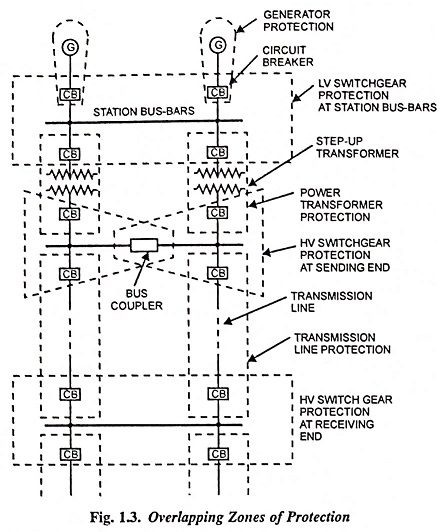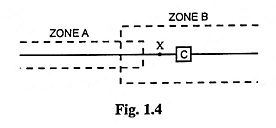Overlapping Zones of Protection:
Overlapping Zones of Protection – In order to provide selectivity to the system it is usual practice to divide the entire system into several protection zones. When a fault occurs in a given zone, then only the circuit breakers within that zone will be opened and thus only the faulty element will be isolated without disturbing the rest of the system.
Depending upon the rating of the machine, its location, relative importance, probability of faults and abnormal conditions etc., each power system component (generator, transformer, transmission lines, bus-bar, cables, capacitors, individual loads, etc.) is covered by a protective zone. A part of the system protected by a certain protective scheme is called protective zone or zone of protection. The entire power system is covered by several protective zones and no part of the system is left unprotected. The protection zone usually contains one or at the most two elements of the power system.
It may be seen from Fig. 1.3 that there is a certain amount of overlapping between the adjacent protection zones. For failures within the region where two adjacent overlapping zones of protection, more breakers will be tripped than the minimum necessary to disconnect the faulty portion. But, if there were no overlap, a failure in a region between zones would not lie in either zone and therefore no breaker would be tripped. The overlap is the lesser evil. The extent of overlap is relatively small, and the probability of failure in this region is low; consequently, the tripping of too many breakers will be quite infrequent.
Protective scheme which permits sensitivity to faults only within a certain unit part of the system allows a higher quality of system protection by virtue of its high degree of sensitivity and its adaptability to fast speed of operation. Figure 1.3 indicates how protection may be set up to operate for faults only in the protected area with overlapping zones of protection of the areas around the connecting circuit breakers.
When it becomes desirable for economic or space saving reasons to overlap on one side of a breaker, the relaying equipment of the zone that overlaps the breaker must be arranged to trip not only the breakers within its zone but also one or more breakers of the adjacent zone, in order to completely disconnect such faults. This is illustrated in Fig. 1.4, where it can be seen that for a fault at X the circuit breakers of zone B, including breaker C, will be tripped; however, this does not interrupt the flow of fault current from zone A, the relaying equipment of zone B must also trip certain breakers in zone A. This is not a disadvantage for a fault at X, but the same breakers in zone A will be tripped unnecessarily for other faults in zone B to the right of breaker C. How for this unnecessary tripping can be tolerated will depend on the particular application.

